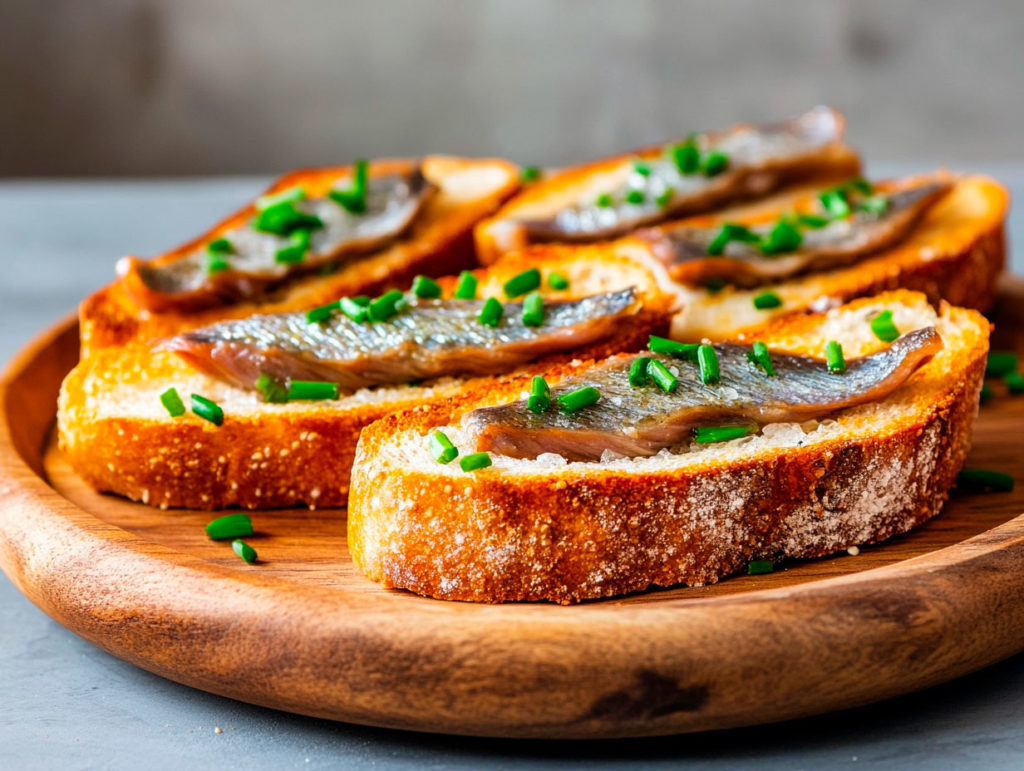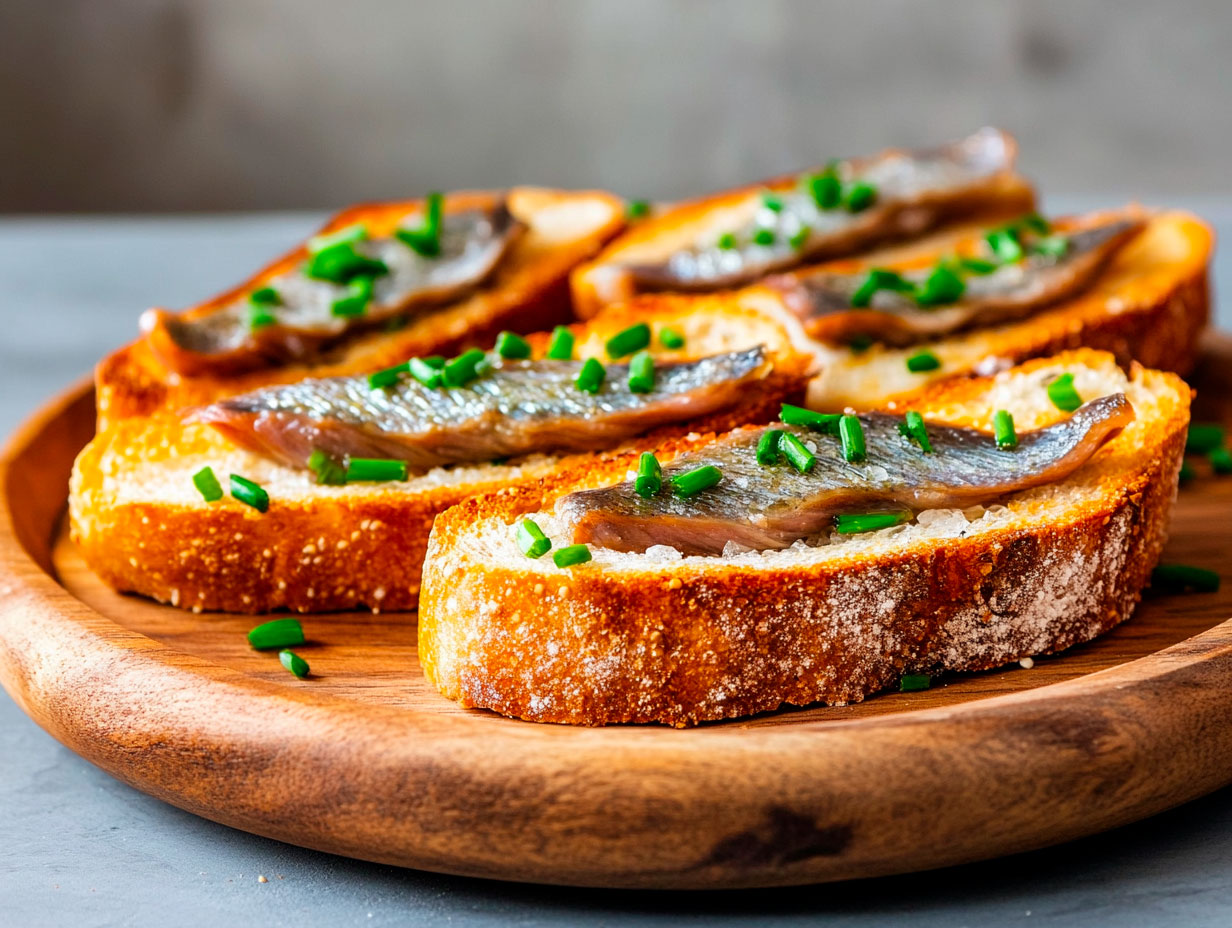Learn about L’anchois au sel from Saint-Jean-de-Luz: a traditional French meal made with salted anchovies, local methods, and Basque culinary heritage.
A preserved fish with deep roots in the Basque coast
L’anchois au sel de Saint-Jean-de-Luz is a traditional preserved fish from the French Basque Country. It refers to anchovies that are salted and matured following artisanal techniques. These fish are typically caught in the Bay of Biscay and processed in the port town of Saint-Jean-de-Luz, located in Pyrénées-Atlantiques in southwest France.
This product is part of the culinary heritage of the Basque coast and reflects centuries of fishing traditions. Known for its preservation method rather than a cooking process, this dish is used as an ingredient in French and Basque cuisine, often served with bread, peppers, or tomatoes. It is not a dish consumed on its own but one that brings flavour and depth to other preparations.
Origins and historical background
A fish preserved since the 17th century
The anchovy industry developed in Saint-Jean-de-Luz in the 1600s, with fishing communities establishing salting techniques to preserve their catches without refrigeration. This method allowed anchovies to be stored for long periods and transported inland or overseas.
The technique was imported and adapted by Basque fishermen who were also active in cod fishing in Newfoundland. Over time, salted anchovies became common in Spanish, Basque, and French cooking. Saint-Jean-de-Luz, with its strategic Atlantic location, became a key harbour for this trade.
Anchovy fishing in the Bay of Biscay
The anchovies (Engraulis encrasicolus) used for this preparation are caught from April to June, when they migrate closer to the coast. Boats from Ciboure and Saint-Jean-de-Luz use purse seine nets to catch them in large quantities, then land them for immediate sorting and processing.
Fresh anchovies are typically 10 to 15 cm long (4 to 6 inches), and each fish weighs about 20 grams. Once caught, they must be processed within 24 hours to maintain their quality.

Preparation method: salting, maturation, cleaning
The salting process
The first step is cleaning and gutting the fresh anchovies. They are then layered in wooden or plastic barrels with coarse salt, following a strict ratio: one layer of fish, one layer of salt.
The barrels are sealed and weighted to press the anchovies naturally. Over time, the salt draws out moisture and helps fermentation. This curing process lasts at least three months, sometimes up to six.
During this period, enzymes break down muscle fibres, and the fish develop their distinct umami taste and firm texture. This is what differentiates them from vinegar-cured anchovies found in some Spanish products.
Desalting and fileting
After curing, the anchovies are washed, filleted by hand, and packed. Some producers offer them in salt, meaning they are kept semi-dry and still require soaking before use. Others sell anchovy fillets in oil, ready to eat.
The final product has a dark red-brown color, a soft but firm texture, and a salty, intense taste. Each kilo of final product requires about 2.5 kg of fresh anchovies.
Culinary uses: eating in France with salted anchovies
In Basque and French cuisine
L’anchois au sel is widely used as a culinary base in French meals, especially in southern France. In the Basque Country, they are served with piperade (a tomato, pepper, and onion mix) or added to tapas and pintxos. In Provence, similar anchovies are crushed into anchoyade, a spread with garlic and olive oil.
The anchovies are rarely cooked directly. Instead, they are used to enhance sauces, stews, or vinaigrettes. Their high salt content means a small quantity is enough to flavour a dish. In Nice, for example, they are essential in salade niçoise and pissaladière.
How to prepare them at home
Before eating, anchovies preserved in salt should be soaked in cold water or milk for 30 minutes, then dried. The filets are then separated from the bones and served as is or mixed with oil. A jar of high-quality anchovies in salt (200 g) costs around €9 (approx. £7.70 / $9.60) in local shops.
They are typically stored in the refrigerator and last several months once opened, if kept in oil or under salt.
Local production in Saint-Jean-de-Luz
Artisans and cooperatives
Several producers in Saint-Jean-de-Luz and the nearby town of Ciboure maintain this tradition. Notable names include Paries, Roque, and Conserverie Jean de Luz. They rely on manual techniques and source fish only from certified coastal fisheries during the regulated season.
The industry supports local employment in fishing, salting, and processing. Many workshops are open to visitors, especially in summer. In markets and festivals, salted anchovies are often promoted as part of the Basque food identity.
Quality and labelling
While there is no AOC or PDO label yet, some producers are pushing for geographic protection to secure the name “Anchois au sel de Saint-Jean-de-Luz.” Quality is ensured by small-batch processing, careful cleaning, and low-temperature maturation.
Buyers should check for origin labels, processing methods, and packaging dates. Anchovies from industrial origins, especially from Asia or South America, are often lower in flavour and not preserved in salt.
Nutrition, sustainability, and market value
Nutritional properties
Anchovies are rich in omega-3 fatty acids, calcium, and proteins. A 100 g portion provides around 210 kcal, with 25 g of protein and 10 g of fat. Their high sodium content (over 3500 mg per 100 g) means they must be consumed in moderation, especially for people with salt restrictions.
They are a valuable protein source for Mediterranean diets. Their intense taste helps reduce the need for added salt in cooking.
Fishing regulations and sustainability
Anchovy fishing in the Bay of Biscay is subject to EU quotas and seasonal limits to prevent overfishing. Since 2005, stock monitoring has improved. The ICES (International Council for the Exploration of the Sea) supervises fishing volumes, and French authorities enforce local restrictions.
This has helped stabilize fish populations, although climate change and ocean temperature shifts are affecting future projections. Anchovies reproduce quickly and in large numbers, making them relatively resilient compared to larger fish.
Why this preserved fish matters in France
L’anchois au sel de Saint-Jean-de-Luz remains a staple of food in France, especially in the south-west and Mediterranean regions. It represents a preserved way of cooking in France, based on salt, patience, and craftsmanship.
Although simple in appearance, its production method is detailed and manual, and its taste is specific to its origin. Its value lies in its use as an ingredient that brings depth to local recipes. Visitors to Saint-Jean-de-Luz can buy these anchovies in markets or specialised shops for prices ranging between €7 and €12 (approx. £6 to £10 / $7.50 to $13) per 200 g jar, depending on origin and packaging.
This dish is not widely produced at an industrial scale, which explains its limited availability outside France. It remains part of what defines a traditional French meal.
Cook in France is your gateway to French cuisine and gastronomy in France. Get in touch for your next cooking workshop.
